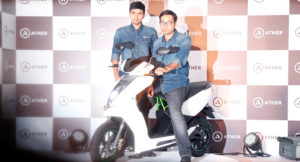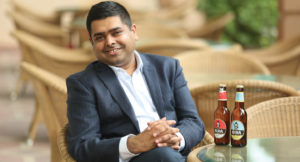Tata Starbucks is the coming together of two iconic brands. 34-year-old Avani Saglani Davda, the company’s CEO, explains to us why her game plan for Starbucks in India is to “grow respectfully”

What happens to a business when two iconic brands come together? The Tata Group, of course, is often referred to as the salt-to-software Indian conglomerate now galloping to expand its various group companies globally. From a branding perspective, Tata Group is arguably the greatest corporate brand ever to be built out of India. Writer and Historian, Morgen Witzel, who analyzed the Tata Group for his book on corporate branding, said in an interview with The Smart CEO, “The greatest thing about the Tatas is the passion and how deeply the leaders within the Tata system feel about the Group.” It is the Tata Group’s ability to build an army of long-term professional leaders that has played a stellar role in shaping up the corporate brand.
On the other hand, Brand Starbucks is known to make coffee drinking look glamorous. Horward Schultz, the founder of Starbucks Corporation (Starbucks), is credited with singlehandedly infusing the words ‘entrepreneurship’ and ‘marketing’ into the coffee drinking experience. The original Starbucks was founded in 1971 in Seattle and served wonderful coffee, but then Schultz saw the potential is building a coffee marketing company that would eventually spread across the world. He bought over the original Starbucks in 1987 and scaled it up; Today, Starbucks has a market capitalization of US $57.14 billion (as of going to press).
In his book titled Pour your heart into it, Schultz writes:
“Starbucks, as it is today, is actually the child of two parents.One is the original Starbucks, founded in 1971, a company passionately committed to world-class coffee.The other is the vision and values I brought to the company: the combination of competitive drive and a profound desire to make sure everyone in the organization could win together. I wanted to blend coffee with romance”
In India, Starbucks now has a third parent in Tata Group and it is spearheaded by the 34-year-old Avani Saglani Davda, a young leader born out of the group’s leadership development program at Tata Administrative Services (TAS).

Rise to the top
In 2002, Davda was a young MBA student at the Narsee Monjee Institute of Management Studies in Mumbai. In her own admission, she didn’t comprehend the size and scale of the group when she joined TAS, straight out of college. It was her first job and she had the opportunity to work with various group companies. At Taj hotels, she oversaw the construction of new hotels, worked in sales and marketing and “understood the nuances of building a brand in the service sector”. She then worked with Tanishq, where she realized how the magic of marketing, branding and advertising could do wonders to a business.
Davda says, “The wonderful thing about the group is that they identify us youngsters early and invest in us. They nurture leaders – very beautifully – and look for a grounded person to lead their businesses. I am very grateful for the kind of experience I’ve had at the Group.” Davda’s next move within the Tata system has probably changed her life. She became executive assistant (EA) to Tata Group veteran R.K. Krishna Kumar. This was in 2008 when Kumar was spearheading a variety of projects including building a cancer hospital (for the Tata Trust), serving on the governing board of Tata Institute of Social Sciences (TISS) and of course, playing a leadership role in exploring the joint venture between Tata Coffee and Starbucks. “Working with Mr. Krishna Kumar’s office added that touch of humanity to the way I conduct business,” adds she. It is this element in her that probably led her to lead the Tata-Starbucks JV in India.
As in the case of any partnership, the chemistry between the two entities is the first step to sealing the deal. “When Mr. Ratan Tata, Mr. Krishna Kumar and Horward Schultz met, it was wonderful how the thought process of the two groups were similar. The care and nurturing required to operate a business of this nature was easily understood,” explains Davda. It was the sustainability of the venture that was discussed in detail and this meant ensuring that the coffee growing community, baristas and employees (or Starbucks Partners as the employees are referred to globally) were as happy as the consumers. While the key business metrics like revenues, profitability and IRR were discussed, both parties realized that in a services business the emotional health of the staff was paramount. As Davda says, “It is what happens over the coffee counter that brings a store alive.”
The India game plan
Starbucks is no novice to entering new markets. It operates over 17,000 stores in over 50 countries across the world. Of late, it has turned its attention to growing rapidly in the Eastern hemisphere, yet its foray into India is like no other. It’s not only the coming together of two iconic brands; for the first time in any new market, Starbucks entered into a partnership at the coffee roasting level. The birth of the partnership began with setting up of the first Starbucks roasting plant outside of the U.S. and Europe. Davda says, “Our approach to working with the coffee growing community in India is crucial to how we operate.”
At the end of the day, Tata Starbucks is a coffee marketing company that sells an experience. Be it the uniquely designed stores, the coffee, the brand, the story that is woven into the various blends served, it is the ability to execute the back-end (coffee sourcing, barista training, pricing etc.) and the front-end (in-store experience, coffee, food, the communication with stores manager/baristas) with perfection. As Schultz wrote in his book, it is about elegance and style married to the ability to ensure everyone in the organization can win together.
Davda recalls a conversation she had with Schultz during a shareholder’s meeting in March earlier this year. “For Schultz, it is the Starbucks Partners’ happiness and passion that is crucial. The first question he asked when we met was: Are the partners excited about the India Estates Blend? It wasn’t about number of stores or expansion plans. It was a question about his people.” The India Estates Blend is the coffee brewed from Arabica beans sourced from Tata Coffee’s four estates in Chickmagalur in Karnataka. Over time, this Indian blend will be taken into global markets and Schultz wanted to ensure that his people shared that passion for coffee and the work they do.
Like in all Starbucks operations across the globe, the contribution the company makes to the life and career of its people is critical. Tata Starbucks operates a training academy where the teaching is not only about how they contribute to the company but also the reverse – how the company can contribute to its people’s lives. The program understands the career aspirations of each of these individuals and works towards delivering on the same.
In its U.S. operations, Starbucks has taken this one step further. It formed a formal partnership with Arizona State University (ASU) to help its employees complete undergraduate programs. Branded the Starbucks College Achievement Plan, it is focused on helping the company’s employees who work for more than 20 hours a week to complete an undergraduate program from ASU with the tuitions fully reimbursed.
The other key decision points at Tata Starbucks include choice of real estate, formats, the pricing strategy and scaling up plans in terms of geographical expansion. Till date, the company has opened 54 stores across Bengaluru, Delhi-NCR, Mumbai, Pune and Chennai. The first store in Hyderabad is opening shortly. Davda is, however, tightlipped about sharing store expansion plans. She simply says, “We give 200 per cent to every store opening, one store at a time. Financial success has never been a problem for either Tata Group or Starbucks. The numbers will come as we deliver on the experience. That is why I often mention that our game plan is to ‘grow respectfully’ in India.”
From an entrepreneurship perspective, the Starbucks story teaches us one thing – the magic wand a passionate entrepreneur can bring into any situation. Starbucks’ US $57.1 billion market cap comes, thanks to the vision of one man who identified a basic human need – to have a third location outside of home and office which felt like his/her own.
![]()
From a consumer behavior perspective, Davda believes that there is potential for outlets in over 50 cities in India. “A young graduate in Pune or Baroda thinks very similarly to a person of the same age group in a New Delhi or Mumbai. So, we’d be grossly mistaken if we looked only at the top 10 cities,” she explains. In terms of formats, Tata Starbucks is now focused on high-street stores, some office buildings and is positioned in the premier segment. There’s potential for several other formats – stores in select neighborhoods, stores inside universities and maybe even drive-throughs like in the U.S. Davda did not share details on how the pricing strategy came about or investment needed per outlet. However, from the looks of it, it seems like the current focus is on nurturing the brand in India, fine-tuning the relationship with the suppliers and the coffee growing community and understanding the right way to build its team, which is currently at over 1000 people. Personally for Davda, it is an opportunity to build an endearing organization that cares about its employees and customers with equal passion.
Starbucks and entrepreneurship
From an entrepreneurship perspective, the Starbucks story teaches us one thing – the magic wand a passionate entrepreneur can bring into any situation. Coffee is a commodity that can be brewed at home in a jiffy. People do not come into a Starbucks outlet only for the coffee. In reality, people come in to while away time, to entertain themselves, to have conversations, to meet friends and colleagues from work, in an ambience that is fun.
Starbucks’ US $57.14 billion market cap comes thanks to the vision of one man who identified a basic human need – to have a third location outside of home and office which felt like his/her own.
The design thinking that goes into building a Starbucks outlet and brings the interiors alive is crucial to the Starbucks experience and it’ll be interesting how this unfolds in the Indian market.
For Davda, it is an opportunity of a lifetime to build a long-term sustainable venture that brings happiness to its customers, employees and its various partners. The Tata Starbucks story will be the coming together of passion for coffee, business and brand building and empathy for its various stakeholders.
HOWARD SCHULTZ, THE WRITER
Howard Schultz’s journey as an entrepreneur first and then a turnaround artist is accounted for in his two books – Pour you heart into it: How Starbucks built a company one cup at a time & Onward: How Starbucks Fought For Its Life without Losing Its Soul. The latter is recommended reading for any entrepreneur going through a challenging phase (which I guess is all the time!). In Onward, Schultz describes the finer details of how he turned around the company and restored profitability in a very tough economic climate in the U.S. This is the story of Schultz’s entrepreneurial journey after he returned to lead day-to-day operations in 2008, after a gap of eight years.
Avani Davda recalls a story she’s fond of from the turnaround phase: “Once Howard returned to the company as CEO, he shut down all 7,100 Starbucks stores in the U.S. for three and half hours to retrain the baristas on how to brew the perfect espresso. It is this kind of drastic steps that crafted the turnaround
TAKING DESIGN TO THE NEXT LEVEL
Globally, Starbucks is completely rethinking interior design and store formats. For example, in Switzerland, the company (in partnership with Swiss train company SBB) started a whole Starbucks store that operates in a double-decker train that runs from Geneva airport to St. Gallen. Commuters can enjoy that cup of coffee with the uniqueness of Starbucks interiors complete with leather chairs, wooden tables and the works.
In India, each store is uniquely designed (see pics) with several fun elements sprinkled in, but we believe it’ll be a while before the boundary is pushed a little more like in Switzerland.
STARBUCKS, HIGH ON RISKY INNOVATIONS
In Starbucks’ US operations, Howard Schultz doesn’t worry that much about failure. At least, that’s what it seems like. He rolled out Twitter founder Jack Dorsey-led payment firm Square’s payment services at several of Starbucks outlets, only to leave baristas and customers equally confused. He launched an instant coffee brand Via, which several people at the time of launch felt was not in line with Starbucks passion for “real coffee”. However, Via worked as a brand and is now a global feature.
It’ll be interesting to watch how some of these innovations pan out in India. From retail payments to new business models around delivering coffee, Tata Starbucks’ game plan on innovative, often risky, ideas will be interesting to track.




